Mt Takao is the ideal spot to enjoy nature in Tokyo. There are 8 hiking trails that wind their way up the mountain each with their own attractions. Want a more relaxed pace? Take the cable car or chair lift partway for great views and don’t miss visiting Yakuo-in temple or a soak in the natural hot spring pools.
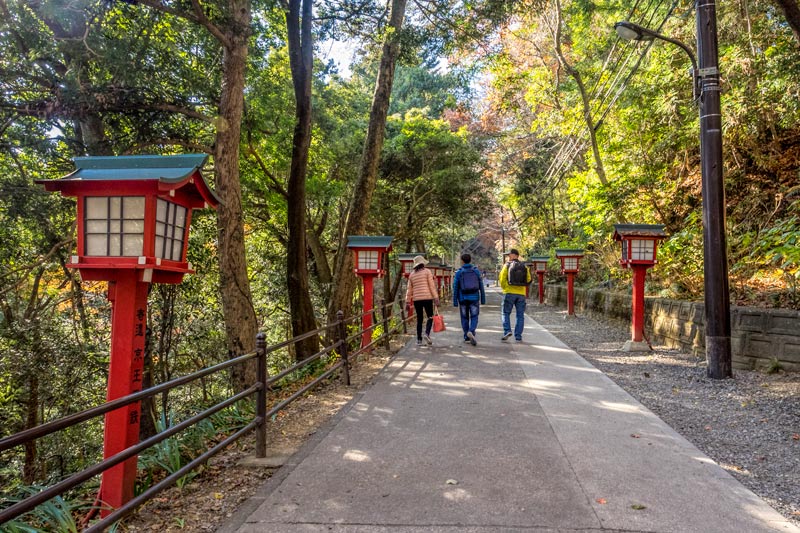
As much as we enjoy spending time in Tokyo we also love to plan day trips and nature breaks out of the city centre every few days for a change of pace. We recently shared our tips for exploring Todoroki gorge which I highly recommend especially if you only have a few hours to spare but Mount Takao is also a fantastic destination where you can easily spend a day or more if you have the time.
Table of Contents
Why visit Mount Takao
This trip we visited during the autumn leaves viewing season (Koyo in Japanese). This is a lovely time to experience the mountain trails, views and temple but it is also the most popular time of the year to come out here.
Mount Takao is one of Tokyo’s top Koyo spots so you will NOT have the place to yourself, it can be quite busy but to be honest we timed it for mid-week when many locals were at work and it was nowhere near as busy as we expected. We easily got seats on the train and didn’t wait at all for the chairlift on the way up and less than 10 minutes for the cablecar coming back down at the end of the day.
There are multiple ways to enjoy Mount Takao depending on how much time you have available, your fitness and the type of experience you’re after. The main attractions for visiting are the hiking trails and nature, views, seasonal attractions of cherry blossoms and autumn leaves and the temple.
At the base of Takao-san is the Keio Takaosan Onsen Gokurakuyu, offering a variety of natural alkaline hot spring baths. In typical Japanese onsen style, the baths are communal and gender-segregated, tattoos even if covered aren’t allowed.
The onsen is open until 11 pm so it can be a nice treat for a weary body after a day spent on the mountain. Entry is Y1000 – Y1200 for an adult and you can hire towels or bring your own. There’s a restaurant at the onsen and a few other options to eat nearby. Most of the other bath-houses we came across in Tokyo were sento not onsen so this can be a really good option to try a natural hot spring bath in Tokyo if you’re looking for the healing benefits or just relaxation and an opportunity to enjoy the experience.
There’s also a monkey park not far from the top cablecar station that we choose not to visit. It’s a personal decision but if you want to see Japanese macaque monkeys we highly recommend the snow monkeys in Nagano, it’s a long day trip from Tokyo but really worth it especially if you have a day left on your JR pass.
Read more: The answers to all your questions about the Japan Rail pass, including when NOT to buy it!
Getting to Mount Takao from Tokyo city
Mount Takao is in greater Tokyo, while not in the city centre itself you can still get out here by train from Shinjuku in under an hour and for less than $5, making it an easy and inexpensive day trip from Tokyo.
For the detailed timing and prices we use Hyperdia a free online resource for finding all your Japan transport information. While you can download the app in Japan we don’t find it as good and prefer to use the website on our phones too.
The cheapest and most straightforward option is to use Keio Railways, a local train company that leaves from downstairs in the Shinjuku JR station and ride it all the way through to Takaosanguchi station at the foot of Mount Takao. It took just under 50 minutes and cost Y390 for a ticket.
If you want to use the JR pass you can do part of the distance on JR and then switch to Keio Railways for the last section but it will only save you Y210 (around $2), the trade-off is it will take just a little longer and may require an extra transfer.
Exploring Mount Takao
You can see Mount Takao looming up above you as the train pulls into the station and it’s a short walk from there to the base and ticket station.
There are 3 ways to get up (and down) Takao-san. The no-cost option is to walk the whole way. There are 8 different trails and while some are more strenuous than others it’s an uphill walk, not a climb. With the right shoes, fitness and available time that is an option for most people. The other two options do have a small cost associated with them and deposit you just over halfway up the mountain.
Both the chairlift and cablecar option cost Y480 one way or Y930 return and you can go up on one and back on the other with the return ticket option which we did. It’s a very reasonable price, there is plenty of walking further up the mountain and they were both fun experiences we’d recommend doing.
The Mount Takao chair lift
The chair lift we took on the way up would make Australian safety officials a little stressed, it’s an old-style design that opened in 1964, the year of the last Tokyo Olympics and is still going strong. I believe it was a single chair system originally but you can now have two people to a seat so it has been upgraded at some point.
Like a ski lift you get on while it’s moving and there’s no bar to hold or keep you in place. As you sit down it rocks to a slightly reclined position so you don’t feel like you are in any danger of falling out and on the sections when you’re higher above the mountain there’s a drop net below.
You board at Sanroku Station at the base and travel up to the ridgeline midway up Mt Takao which is called the Sanjo Station. While they are separate stations the chairlift and cablecar start and end very close to each other.
I thoroughly enjoyed it, it’s a sedate ride taking around 10 minutes to make the ascent with great views along the way. If you have younger children, a lot of gear with you or struggle with moving quickly into position you may prefer the cablecar option, I’ll cover that a bit later.
Taking your seat is particularly entertaining if you speak limited to no Japanese. There was a lot of pointing at the seat, your bottom and miming a big drop when you get the ‘safety talk’ as you take your seat. All up it’s a lot of fun and we strongly suggest you take it one direction or the other. I enjoyed the autumn leaves on the way up but in hindsight it might be even better on the way down if it’s a clear day as you’d see out to Tokyo and Yokohama.
The Mt Takao hike
At the top station you might want to use the facilities, it’s a mountain and toilets are in short supply, use them when you can. It’s only a few minutes walk from here to the cablecar station and about 5 minutes until you come to the Beer Garden, one of the few food options on Mt Takao.
The beer garden has outdoor seating with a breeze and lovely views, on a clear day you might even be able to pick out the Skytree back in the city. It’s an all you can eat and drink restaurant where for 90 minutes you have your selection of Japanese and international dishes and a variety of alcoholic and non-alcoholic drinks. We didn’t eat here but did think it was a giggle that they have men’s price and women’s price, that’s not something I’ve seen at a buffet before.
Another 5 minutes or so along and you come to some small stalls selling souvenirs, and a few drink and snack options. Yakuo-in temple is about a 20-minute direct walk from here but we took a detour along the way.
Miyama Bridge
If you want to see the Miyama suspension bridge, the only one of its kind on the mountain you would detour off the main path and join trail 4 not for past here. You can take it all the way to the summit or the shorter detour from this end through the beech forest to the bridge. It’s highly recommended to see the fresh new leaves in early summer.
The Otoko-zaka
When the road branched we went left and climbed the stairs, this is the Otoko-zaka or 108 steps. The number 108 is a spiritual number in Buddhism and you’ll see it repeat often in things like mala beads and mantra repetition during meditation.
The number is also commonly seen on stairs and you’ll also observe it at temples and even along the Great Wall in China. You may find you naturally slow your pace on the stairs, breathe more deeply, look out to the distance or be more present and mindful of your footing.
The Busshari Stupa
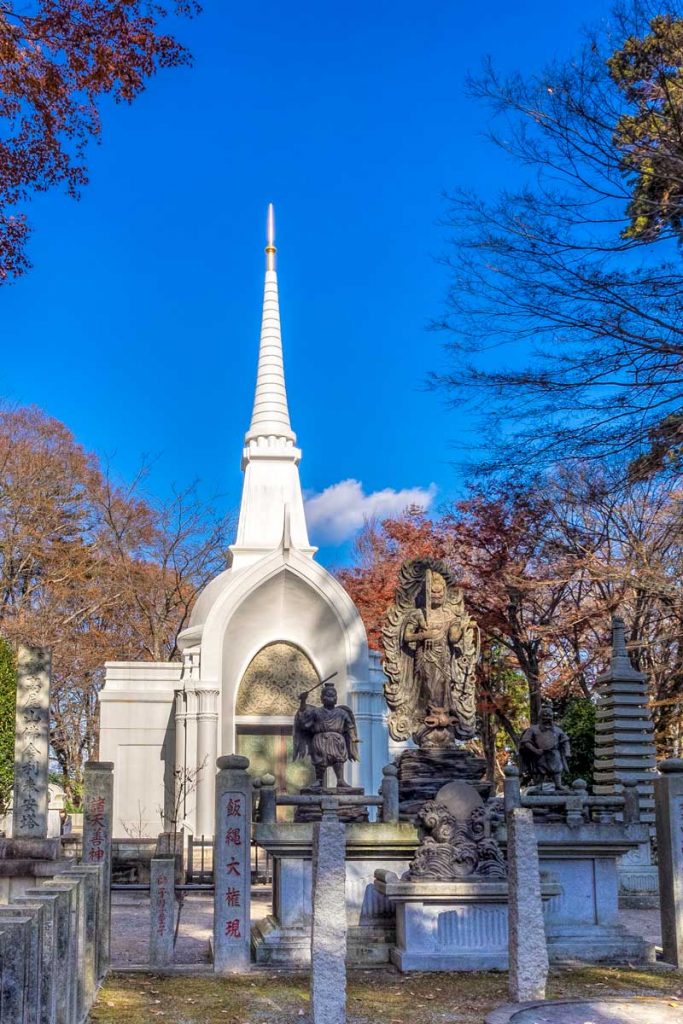
At the top we found yet again that we can’t resist the unknown and having the focus of a squirrel we took the narrow and less travelled path and stairs up the hill to the right to see where it would go. At the top was an impressive Buddhist stupa in a style more common in Tibet and across southeast Asia. We spent a little time up here and found it very peaceful both in its inherent serenity but also because few others made the detour up.
The relic stupa was built as a symbol of friendship with a temple in Thailand who gifted bone fragments from Buddha to a Japanese youth delegation who visited Thailand in 1931. Like the tiered pagodas more frequently seen in Japan, stupa contain remains or artifacts very important to the Buddhist faith. The Busshari (仏舎利) stupa in this instance refers to the ashes of the historical Buddha, Shakyamuni.
Onna-zaka
We made our way back to the main path and continue towards the top of the mountain, when the path joined again we realised that if we hadn’t taken the stairs and instead gone straight ahead we would have come back to the same point via a slope rather than steps.
The gentle slope is the Onna-zaka and we returned this way later in the day. It is worth knowing in advance though if you have any issues with your knees or just prefer one option over the other. There are also quite a few steps further on if you are going through the temple to the top of the mountain.
The legend of Tengu
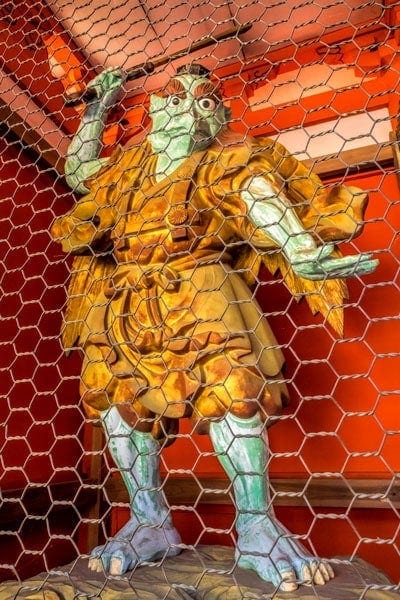
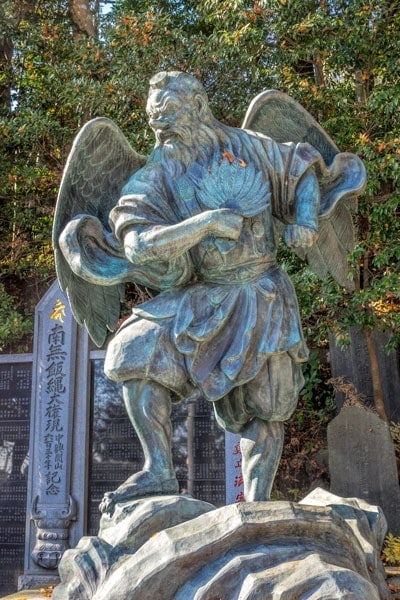
We first came across mention of Tengu when we climbed Mt Misen in Miyajima, there are urban legends of hikers reportedly hear the sounds of his clappers ring out across the hills from time to time. On Mt Takao Tengu is far more visible or at least his statue is. They are found in several places including up at the stupa and they appear as the guardians in the main temple gate at Yakuo-in.
The legend of Tengu dates back to the 9th century but has changed substantially over time. Originally he was a mischievous demon-like character who lived in the mountains tricking hapless people off the safe path into the woods with his music. Later he became associated with both Shinto and Buddhism as a messenger to the Buddhas and gods. At the temple on Mt Takao the role of Tengu is softened and depicted as one who chastises the evil and rewards the good.
The most recognisable image of Tengu depicts a large human-like form with a long nose but another version shows him smaller with a beak-like nose similar to a crow. Both forms appear in the gate guardhouses at the temple on Mt Takao.
Yakuo-in Temple
The head temple on Mount Takao is Yakuo-in. It was established in 744 during the Nara period on the orders of the Emperor as a base for Buddhist practice in eastern Japan. The founding priest was Gyoki who became a monk at the age of 15 in Nara but widely roamed the country. He is credited with bringing mapping to Japan determining boundaries and paving the way for infrastructure and temple complexes. He was involved in the project to establish the Great Buddha statue at Todai-ji temple in Nara and several of the ponds that you will still see there today.
During the 14th century, the priest Shungen Daitoku from the Daigo-ji area in Kyoto carried out restoration on the temple. With his background in ascetic mountain practice he carried out an elaborate ritual dedicated to the deity Fudo Myo that involved burning 8,000 Goma sticks.
The sticks symbolise human desires, the root of suffering and the consuming fire, the wisdom of Buddha. During the ceremony, he had a vision of Izuna Daigongen and enshrined him at the temple. Izuna Daigongen is a local incarnation of Fudo Myo with the beaked features of the smaller Tengu.
It’s an interesting temple to wander through with many buildings. As we were walking around the Izuna Gongen-do hall towards the back of the main temple area a local pointed out to us how the elaborate frieze and panelling were reminiscent of the shrines in Nikko. I hadn’t immediately made the connection, just that they were familiar but he was quite right, there were a lot of similarities.
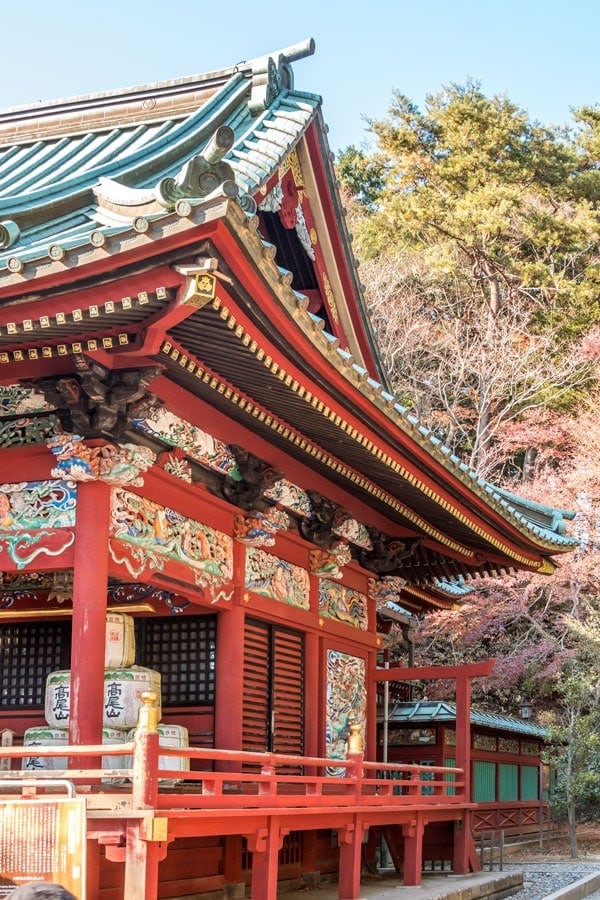
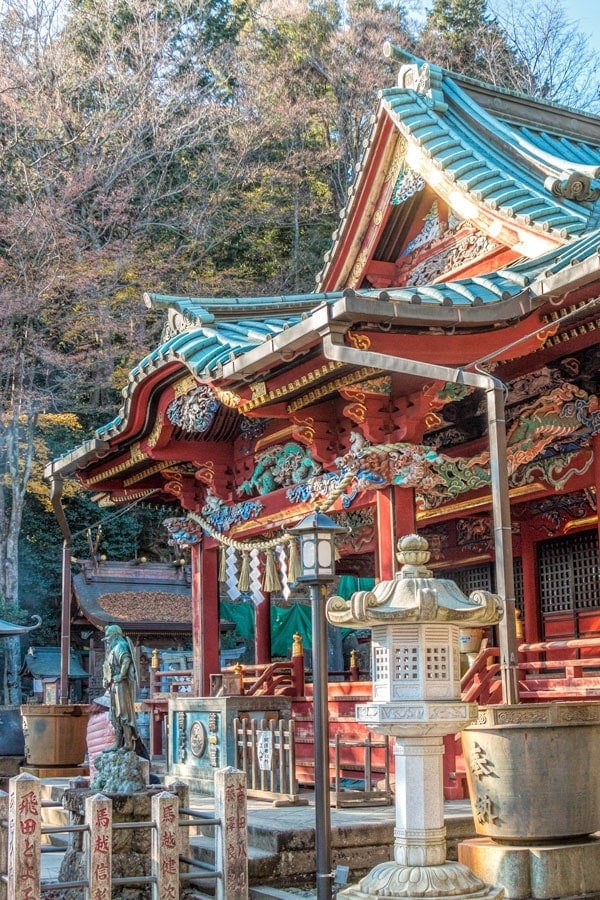
Climbing to the top of Mount Takao
After exploring the temple area you can climb the stairs and continue on to the top of Mount Takao. It’s a wide walking path the whole way and takes another 15 minutes or so uphill walking to the top. There’s a large flat open area at the summit with expansive views out to the city.
While the views are less impressive when it’s hazy as it was the afternoon we went up the autumn leaves made it worth it. There’s a food outlet at the top and toilet facilities but mostly it’s about the views and bragging rights for making it all the way up.
Mount Takao cable car
The other way to get up and down the lower half of the mountain is the cable car. There was a bit more of a queue for that as we headed down late in the afternoon but it was only a couple of minutes wait to board and a 5-minute trip down.
We were standing on the way down and it was quite packed but we did have a great view out the front. If we’d needed a seat we could have stood aside and boarded first on the next trip down. In hindsight for the fun factor, I did enjoy the ride on the chair lift more but for a quick and easy transfer, the cable car is a good choice.
This is Japans steepest cable car and runs for 1,000 metres from Kiyotaki station at the base (an elevation of around 210 metres above sea level) to the Takaosan station on the ridgeline about midway up at 472 metres.
One reason to use the cable car on at least one of your journeys is the little kiosk right before you board selling Hokkaido cheese tarts. You can get these all over the world now, our local shopping centre has a dedicated shop that sells a good version but there is something extra special about these ones. They are super fresh and can be enjoyed in the small seating area looking out across the tree-lined hillside with birds flitting around in the trees below you.
There are two types of tart they sell here, warm and cold. The cold is smooth and delicious, the type I’ve had before in Hokkaido and other places but the warm ones had a different texture altogether. The pastry was buttery and flakey and the filling was melty and soft. I would describe the flavour as more ‘cheesy’ it really was delicious and well worth making time for trying them with a cup of coffee at this surprising little spot.
When to visit Mt Takao
There really is something to see in all seasons at Mt Takao and it can be worth considering including it in your itinerary if you have the time.
Autumn
Particularly the month of November is the most popular time to come to Mt Takao to see the colourful leaves and take part in the Momiji Matsuri.
Winter
With the cooler weather you may feel more like hiking the longer trails and the mountain will be quiet and serene. If you time it well you might even have the opportunity to thee the Yakuo temple decorated in fresh snow.
Spring
The cherry trees are such a symbol of Japan and popular with most tourists who visit, your best chance of seeing them in bloom on and around Mt Takao is in early April but it does vary from year to year. They’ll welcome you from the entry as you buy your tickets for the chairlift or cablecar through to your view from the peak.
Summer
The early summer will see the vibrant green of the new leaves and the mountain may feel a little cooler and more refreshing than the city as the humidity hits. It’s also popular for the Yamayuri flowers, the Mountain Lilly, with their golden rays.
Festivals and events on the mountain
We’ve mentioned before that when we are visiting Japan we usually try to time it to include a couple of local events or festivals, preferably in a smaller area where they have a bit of a community spirit. A few you might consider when planning a trip to Mt Takao are:
- The year starts with prayers for peace and happiness at the light welcoming festival of Geikosai in January.
- Setsubun-e takes place on the 3rd February each year, it is the celebration that marks the end of winter and coming of spring in the almanac and takes places in Yakuo-in temple to drive out any bad luck and welcome happiness. We have several places we love to celebrate Setsubun including in Gion in Kyoto but this would make a great alternative in Tokyo. Setsubun is an important day on the calendar but not a holiday so if it falls on a weekday events like these are less crowded.
- Hiwatarisai is the fire-walking ceremony in March where practitioners of Shugen-do walk on the burning coals. We’ve seen this at Gango-ji temple in Nara and it’s impressive. A top tip for other newbies is that they burn green branches when starting the coals, it smells divine but creates a thick smoke and can sting your eyes so try to pick a spot upwind of the smoke to watch that part.
- In April and May you’ll have Wakaba-matsuri or new leaf festival as the trees sprout their new season foliage, there is also some cherry blossom to see from the chairlift and lookout but that’s not something the mountains is as well known for. Traditional performances are held to mark this season.
- Summer sees the Takao Beer garden open from July to September near the cablecar station with great night views back towards the city. An opportunity to extend your stay into the evening.
- Autumn brings the Momiji Matsuri with the coloured leaves and a variety of performances and events throughout November, the busiest time of year on the mountain.
Inspired? Save to Pinterest to refer back to later
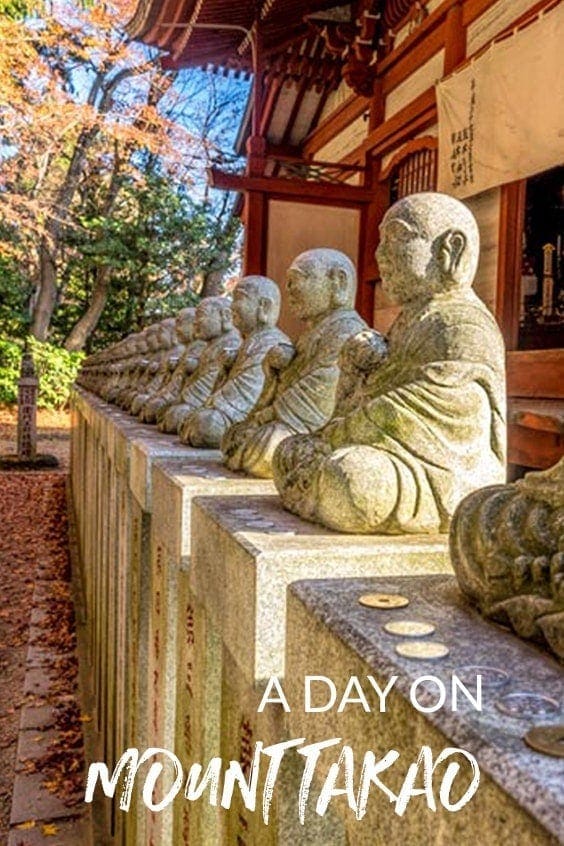

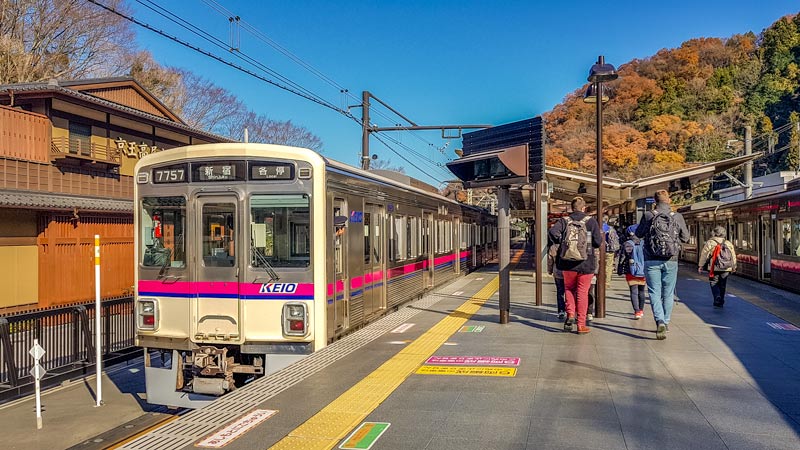
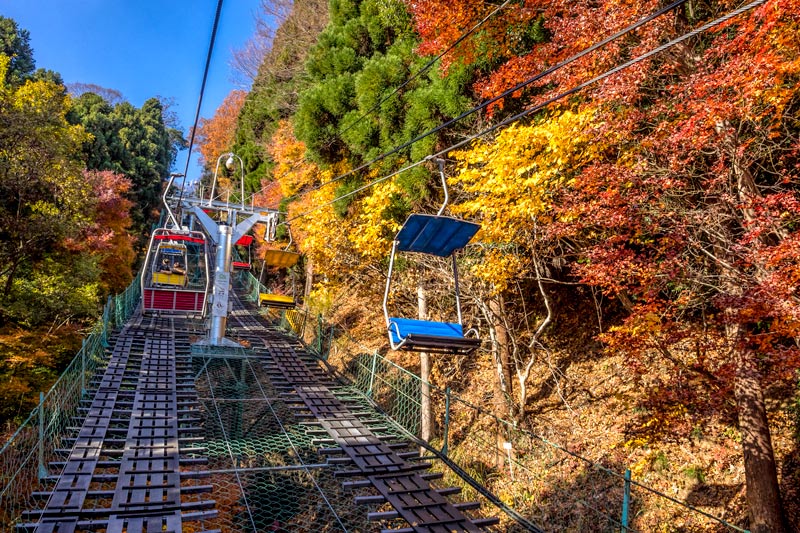
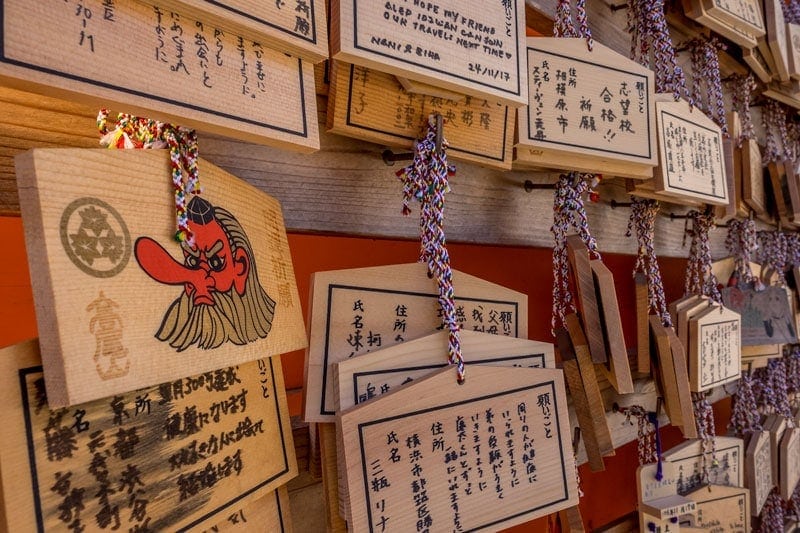
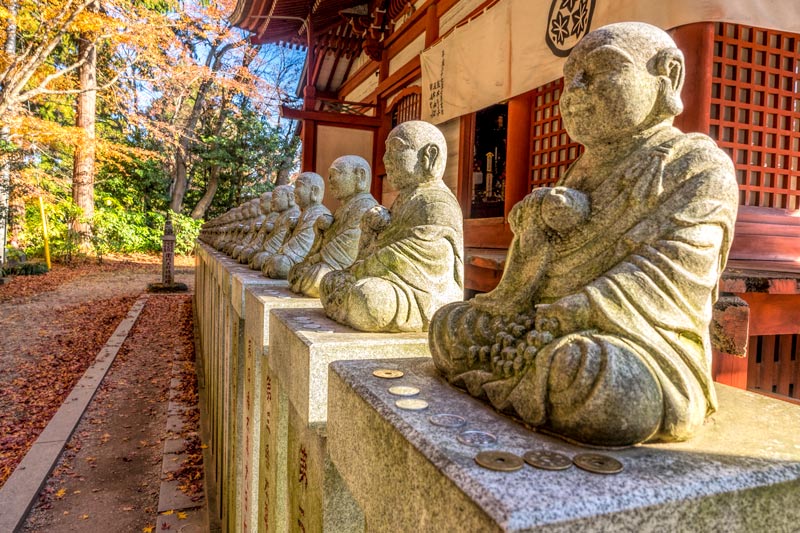
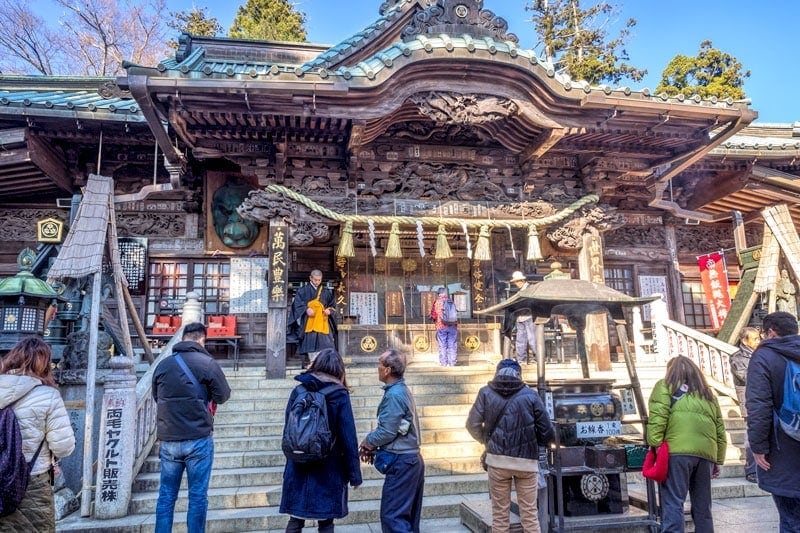
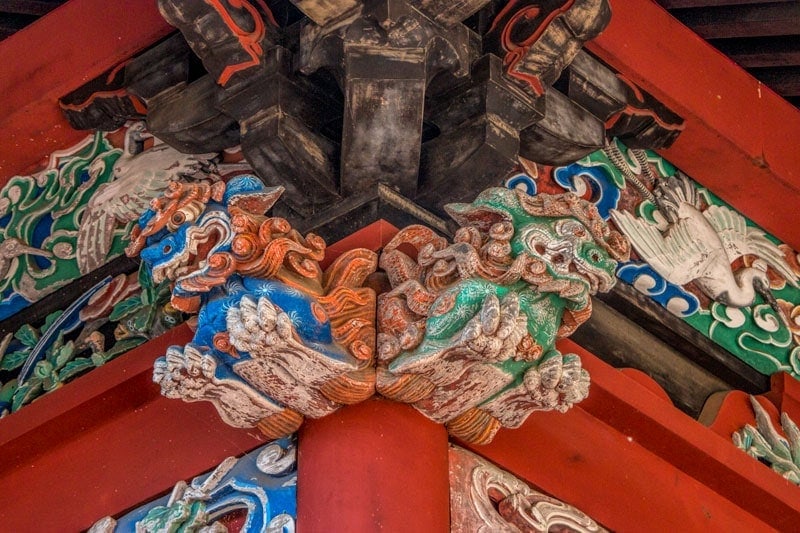
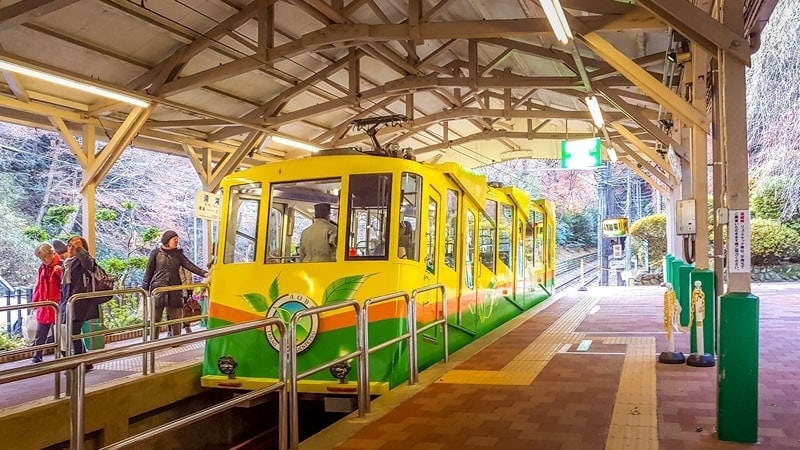

julie
Tuesday 8th of January 2019
Thank you for your post. I have been to Japan a couple of times and expect to go a couple more so I will be putting Mount Takao on my list of things to do.
aFabulousTrip
Tuesday 15th of May 2018
Nice article, I would love to visit Japan and some temple as well :)
Matt Demon
Friday 4th of May 2018
Nice post! Thanks for sharing.
Ryan Biddulph
Friday 27th of April 2018
I love visiting spots in Autumn Toni. Mount Takao looks so serene....and even better with fewer folks ;) Picking a mid-week time was key. Impossible to avoid tourists or even ex-pats traveling through town yet, if you choose the proper window, you can have a genuine experience while not being overrun by humans. We always visit popular spots at odd hours, mid-week. Avoid those weekends guys! Mid-week or even early week is the time to go, off peak.
Ryan